Method for Systematic Assessment of Mobile Network Coverage for Logistic Applications on the German Highway
Abstract
:1. Introduction
1.1. Smart Logistic Applications
1.2. Cellular Networks
1.3. Questions of Research and Contribution
- Does the experimental setup used in this study provide reproducible and consistent measurement results?
- How can different measurements, with spatial variation in vehicle position along the road under analysis, be compared?
- What is the level of consistency assessed by the spatial correlation between different measurements with variation in time, speed, and direction?
- What is the level of consistency based on the confidence per measured position?
1.4. Organization of this Publication
2. Related Work
2.1. Smart Logistics
2.2. Performance Measurement of Cellular Networks
3. Materials and Methods
3.1. Experimental Setup
3.2. Data Preparation and Analysis Flow
3.3. Region of Analysis
4. Results
4.1. RSRP Measurements
4.2. RSSI Measurements
4.3. RSRQ Measurements
4.4. Correlation Analysis
5. Discussion, Conclusions, and Outlook
- Does the experimental setup used in this study provide reproducible and consistent measurement results? Yes, the measurements were spatially and temporarily consistent.
- How can different measurements, with spatial variation in vehicle position along the road under analysis, be compared? The authors implemented a GNSS-based, virtual odometer which provided the base for the vehicle position. The correlation of different measurements indicates a good ability to distinguish between different network operators.
- What is the level of consistency assessed by the spatial correlation between different measurements with variation in time, speed, and direction? The spatial correlation for different measurements for the same provider was above 0.8, while the correlation coefficient across providers showed values below 0.5.
- What is the level of consistency based on the confidence per measured position? The confidence intervals for a confidence of 0.8 provided consistent limits across all measurements. However, additional measurements are required for further improvement.
Author Contributions
Funding
Data Availability Statement
Conflicts of Interest
Abbreviations
| BEVs | Battery Electric Vehicles |
| CSS | Cellular Signal Strength [28,29] |
| E2E | End to End |
| FTP | File Transfer Protocol |
| GNSS | Global Navigation Satellite System |
| GSM | Global System for Mobile communication (2G cellular network) |
| H2H | Human to Human |
| ICT | Information and Communication Technologies |
| IMS | IP Multimedia Subsystems |
| IoTL | Internet of Things Logistics |
| KPIs | Key Performance Indicators |
| KQI | Key Quality Indicators |
| LTE | Long Term Evolution (4G cellular network) |
| M2M | Machine to Machine |
| MMS | Multimedia Messaging Services |
| MTSI | Multimedia Telephony Services over IMS |
| PoC | Push-to-talk over Cellular |
| QoE | Quality of Experience |
| QoS | Quality of Service |
| RAN | Radio Access Network |
| RSRP | Reference Signal Received Power |
| RSRQ | Reference Signal Received Quality |
| RSSI | Received Signal Strength Indicator |
| sc | spatial correlation |
| SMS | Short Message Service |
| WiFi | Wireless Fidelity |
References
- World Economic Forum. Net-Zero Challenge: The Supply Chain Opportunity. Insight Report. January 2021. Available online: https://www3.weforum.org/docs/WEF_Net_Zero_Challenge_The_Supply_Chain_Opportunity_2021.pdf (accessed on 21 December 2021).
- Rohde & Schwarz, Whitepaper: LTE-Advanced. Available online: https://cdn.rohde-schwarz.com/pws/dl_downloads//dl_application/application_notes/1ma169/1MA169_3e_LTE-Advanced_technology.pdf (accessed on 6 March 2022).
- Kottkamp, M. LTE-Advanced-What’s Next? Available online: https://www.wirelessinnovation.org/assets/Proceedings/2011Europe/2011-europe-1a-kottkamp.pdf (accessed on 6 March 2022).
- Henry, S.; Alsoheily, A.; Sousa, E.S. 5G is Real: Evaluating the Compliance of the 3GPP 5G New Radio System With the ITU IMT-2020 Requirements. IEEE Access 2020, 8, 42828–42840. [Google Scholar] [CrossRef]
- Deutsche Telekom: Mobilfunk Netzausbau. Available online: https://www.telekom.de/netz/mobilfunk-netzausbau (accessed on 6 March 2022).
- Vodafone: Netzkarte für Ganz Deutschland. Available online: https://www.vodafone.de/hilfe/netzabdeckung.html (accessed on 7 March 2022).
- Khatib, E.J.; Barco, R. Optimization of 5G Networks for Smart Logistics. Energies 2021, 14, 1758. [Google Scholar] [CrossRef]
- Song, Y.; Richard, Y.F.; Zhou, L.; Yang, X.; He, Z. Applications of the Internet of Things (IoT) in Smart Logistics: A Comprehensive Survey. IEEE Internet Things J. 2021, 8, 6. [Google Scholar] [CrossRef]
- Tran-Dang, H.; Krommenacker, N.; Charpentier, P.; Kim, D.-S. The Internet of Things for Logistics: Perspectives, Application Review, and Challenges. IETE Tech. Rev. 2022, 39, 93–121. [Google Scholar] [CrossRef]
- Forcolin, M.; Fracasso, E.; Tumanischvili, F.; Lupieri, P. Euridice-IoT applied to logistics using the intelligent cargo concept. In Proceedings of the 17th international Conference on Concurrent Enterprising, Aachen, Germany, 20–22 June 2011; pp. 1–9. [Google Scholar]
- Crainic, T.G.; Gendreau, M.; Potvin, J.-Y. Intelligent freight-transportation systems: Assessment and the contribution of operations research. Transp. Res. C Emerg. Technol. 2009, 17, 541–557. [Google Scholar] [CrossRef]
- Mondragon, A.E.C.; Lalwani, C.S.; Mondragon, E.S.C.; Mondragon, C.E.C.; Pawar, K.S. Intelligent transport systems in multimodal logistics: A case of role and contribution through wireless vehicular networks in a sea port location. Int. J. Prod. Econ. 2012, 137, 165–175. [Google Scholar] [CrossRef] [Green Version]
- Zhou, L.; Lou, C.X. Intelligent cargo tracking system based on the internet of things. In Proceedings of the 15th international Conference on Network-Based Information Systems, Melbourne, Australia, 26–28 September 2012; pp. 489–493. [Google Scholar]
- Lang, W.; Jedermann, R. What can MEMS do for logistics of food? Intelligent container technologies: A review. IEEE Sens. J. 2016, 16, 6810–6818. [Google Scholar] [CrossRef]
- Jedermann, R.; Lang, W. 15 Years of Intelligent Container Research. In Dynamics in Logistics; Freitag, M., Kotzab, H., Megow, N., Eds.; Springer: Cham, Switzerland, 2021. [Google Scholar] [CrossRef]
- Dubolazov, V.A.; Shchelkonogov, A.A.; Temirgaliev, E.R. Use of Internet of things to assess KPI in the transport logistics service. In Proceedings of the International Conference on Digital Transformation in Logistics and Infrastructure (ICDTLI 2019), St. Petersburg, Russia, 4–5 April 2019; pp. 275–279. [Google Scholar]
- Statistisches Bundesamt. Goods Transport. Available online: https://www.destatis.de/EN/Themes/Economic-Sectors-Enterprises/Transport/Goods-Transport/_node.html (accessed on 20 December 2021).
- Gai, R.; Du, X.; Ma, S.; Chen, N.; Gao, S. A Summary of 5G applications and prospects of 5G in the Internet of Things. In Proceedings of the 2021 IEEE 2nd International Conference on Big Data, Artificial Intelligence and Internet of Things Engineering (ICBAIE), Nanchang, China, 26–28 March 2021; pp. 858–863. [Google Scholar] [CrossRef]
- Chettri, L.; Bera, R. A Comprehensive Survey on Internet of Things (IoT) Toward 5G Wireless Systems. IEEE Internet Things J. 2020, 7, 16–32. [Google Scholar] [CrossRef]
- Akpakwu, G.A.; Silva, B.J.; Hancke, G.P.; Abu-Mahfouz, A.M. A Survey on 5G Networks for the Internet of Things: Communication Technologies and Challenges. IEEE Access 2018, 6, 3619–3647. [Google Scholar] [CrossRef]
- ETSI TS 102.250 Series QoS Aspects for Popular Services in Mobile Networks. 2019. Available online: http://www.etsi.org/ (accessed on 27 May 2022).
- Egi, Y.; Eyceyurt, E.; Kostanic, I.; Otero, T.C.E. An Efficient Approach for Evaluating Performance in LTE Wireless Networks. In Proceedings of the International Conference Wireless Networks ICWN 17, Las Vegas, NV, USA, 17–20 July 2017; pp. 48–54. [Google Scholar]
- Kousias, K.; Midoglu, C.; Alay, O.; Lutu, A.; Argyriou, A.; Riegler, M. The Same, Only Different: Contrasting Mobile Operator Behavior from CrowdSourced Dataset. In Proceedings of the IEEE 28th Annual International Symposium on Personal, Indoor, and Mobile Radio Communications (PIMRC), Montreal, QC, Canada, 8–13 October 2017. [Google Scholar] [CrossRef]
- International Telecommunication Union (ITU): ITU-T. E.800 SERIES Definitions of Terms Related to Quality of Service. Available online: https://www.itu.int/rec/T-REC-E.800-200809-I (accessed on 27 May 2022).
- Raida, V.; Svoboda, P.; Koglbauer, M.; Rupp, M. On the Stability of RSRP and Variability of Other KPIs in LTE Downlink—An Open Dataset. In Proceedings of the GLOBECOM 2020-2020 IEEE Global Communications Conference, Taipei, Taiwan, 7–11 December 2020. [Google Scholar] [CrossRef]
- Sommers, J.; Barford, P. Cell vs. WiFi: On the Performance of Metro Area Mobile Connections. In Proceedings of the IMC’12, Boston, MA, USA, 14–16 November 2012; pp. 301–314. [Google Scholar]
- Imoize, A.L.; Orolu, K.; Atayero, A.A. Analysis of key performance indicators of a 4G LTE network based on experimental data obtained from a densely populated smart city. Data Brief 2020, 29, 105304. [Google Scholar] [CrossRef] [PubMed]
- Shayea, I.; Ergen, M.; Azmi, M.H.; Nandi, D.; El-Salah, A.A.; Zahedi, A. Performance Analysis of Mobile Broadband Networks With 5G Trends and Beyond: Rural Areas Scope in Malaysia. IEEE Access 2020, 8, 65211–65229. [Google Scholar] [CrossRef]
- Shayea, I.; Azmi, M.H.; Ergen, M.; El-Saleh, A.A.; Han, C.T.; Arsad, A.; Rahman, T.A.; Alhammadi, A.; Daradkeh, Y.I.; Nandi, D. Performance Analysis of Mobile Broadband Networks With 5G Trends and Beyond: Urban Areas Scope in Malaysia. IEEE Access 2021, 9, 90767–90794. [Google Scholar] [CrossRef]
- El-Saleh, A.A.; Alhammadi, A.; Shayea, I.; Alsharif, N.; Alzahrani, N.M.; Khalaf, O.I.; Aldhyani, T.H.H. Measuring and Assessing Performance of Mobile Broadband Networks and Future 5G Trends. Sustainability 2022, 14, 829. [Google Scholar] [CrossRef]
- Poncela, J.; Gomez, G.; Hierrezuelo, A.; Lopez-Martinez, F.J.; Aamir, M. Quality Assessment in 3G/4G Wireless Networks. Wirel. Pers. Commun. 2014, 76, 363–377. [Google Scholar] [CrossRef]
- Lottermann, C.; Botsov, M.; Fertl, P.; Muellner, R. Performance Evaluation of Automotive Off-board Applications in LTE Deployments. In Proceedings of the IEEE Vehicular Networking Conference (VNC), Seoul, Korea, 14–16 November 2012; pp. 211–218. [Google Scholar]
- Raida, V.; Svoboda, M.; Rupp, M. Real World Performance of LTE Downlink in a Static Dense Urban Scenario—An Open Dataset. In Proceedings of the GLOBECOM 2020-2020 IEEE Global Communications Conference, Taipei, Taiwan, 7–11 December 2020. [Google Scholar] [CrossRef]
- Herrera-Garcia, A.; Fortes, S.; Baena, E.; Mendoza, J.; Baena, C.; Barco, R. Modeling of Key Quality Indicators for End-to-End Network Management: Preparing for 5G. IEEE Veh. Technol. Mag. 2019, 14, 76–84. [Google Scholar] [CrossRef]
- Laselva, D.; Mattina, M.; Kolding, T.E.; Hui, J.; Liu, L.; Weber, A. Advancements of QoE assessment and optimization in mobile networks in the machine era. In Proceedings of the 2018 IEEE Wireless Communications and Networking Conference Workshops (WCNCW), Barcelona, Spain, 15–18 April 2018; pp. 101–106. [Google Scholar] [CrossRef]
- O2: Willkommen im Sehr Guten Netz von O2. Available online: https://www.o2online.de/netz/ (accessed on 9 March 2022).
- Map Provided by OpenTopoMap. Based on OpenStreetMap, OpenStreetMap Contributors. Available online: https://www.openstreetmap.org (accessed on 5 March 2022).
- Teltonica Wiki Knowledge Base. Available online: https://wiki.teltonika-networks.com/view/RSRP_and_RSRQ (accessed on 21 December 2021).
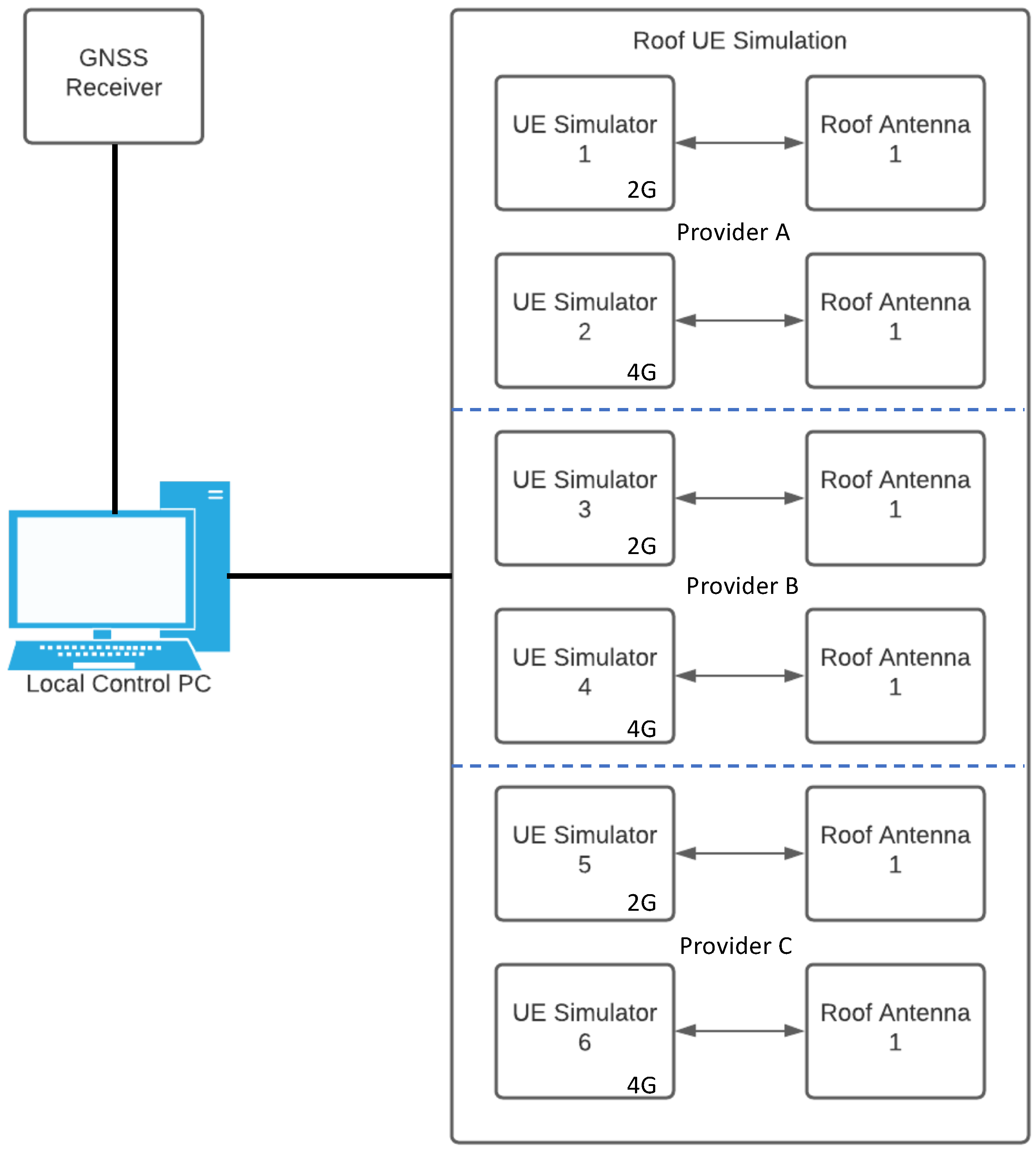
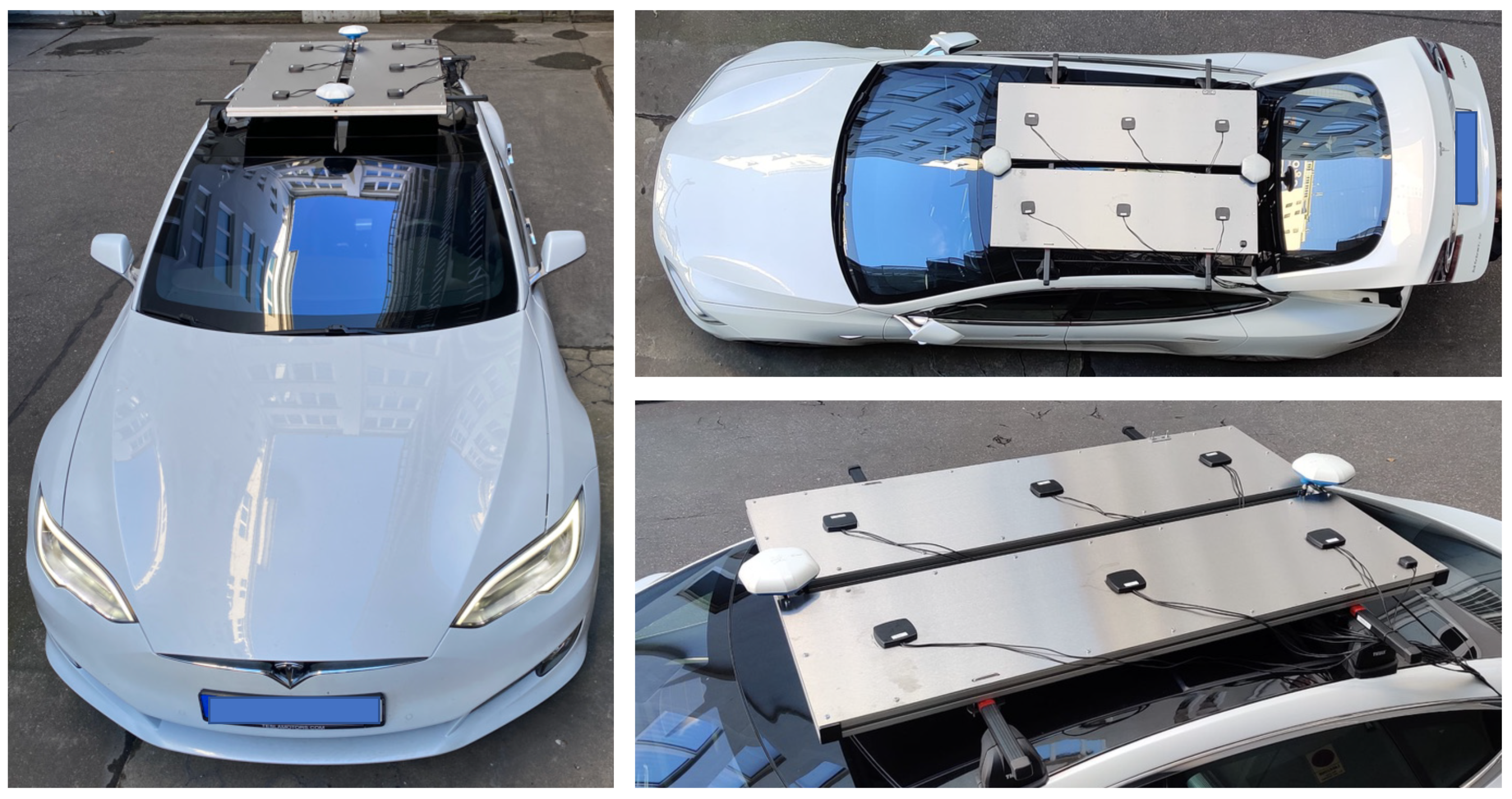

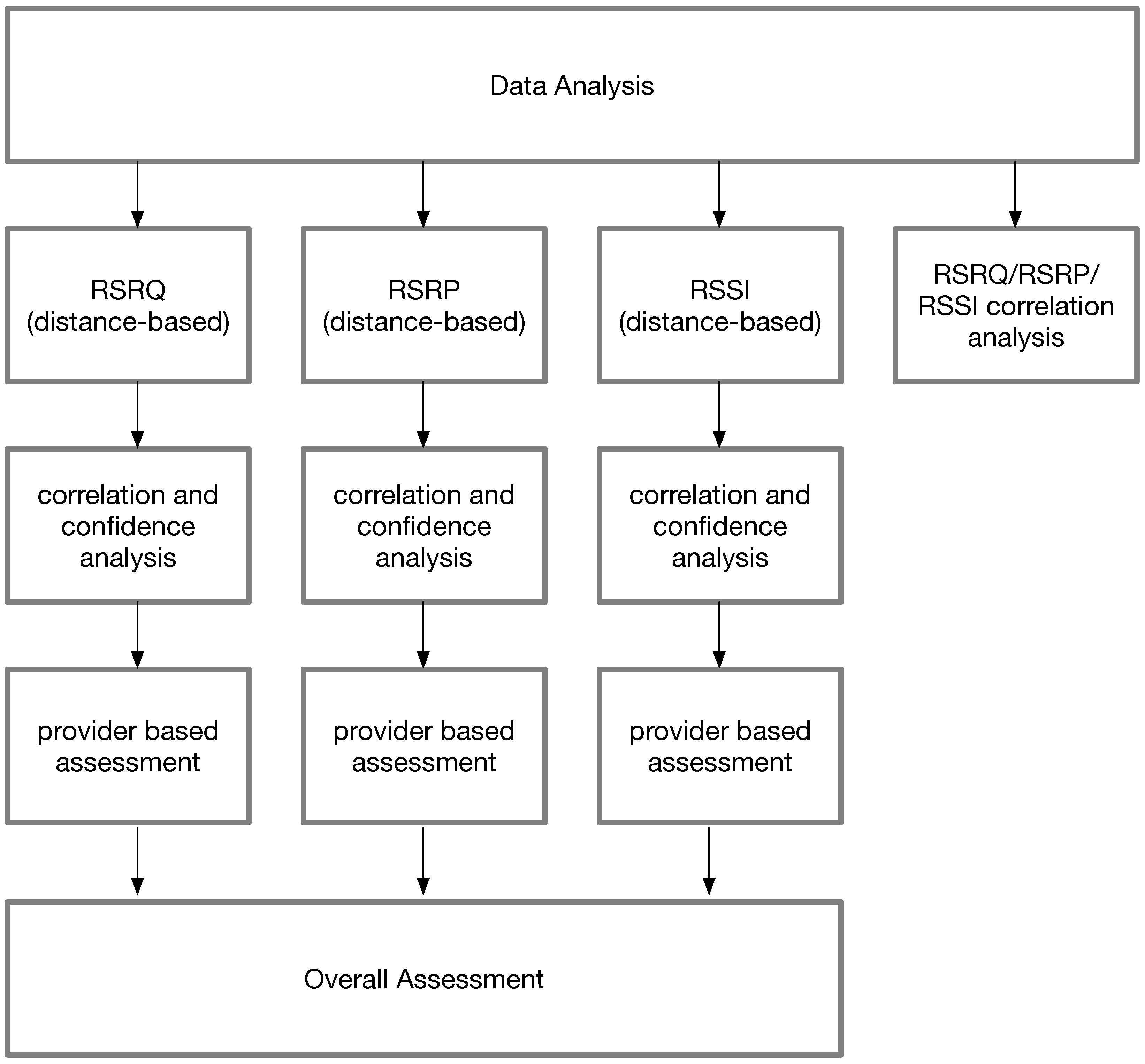
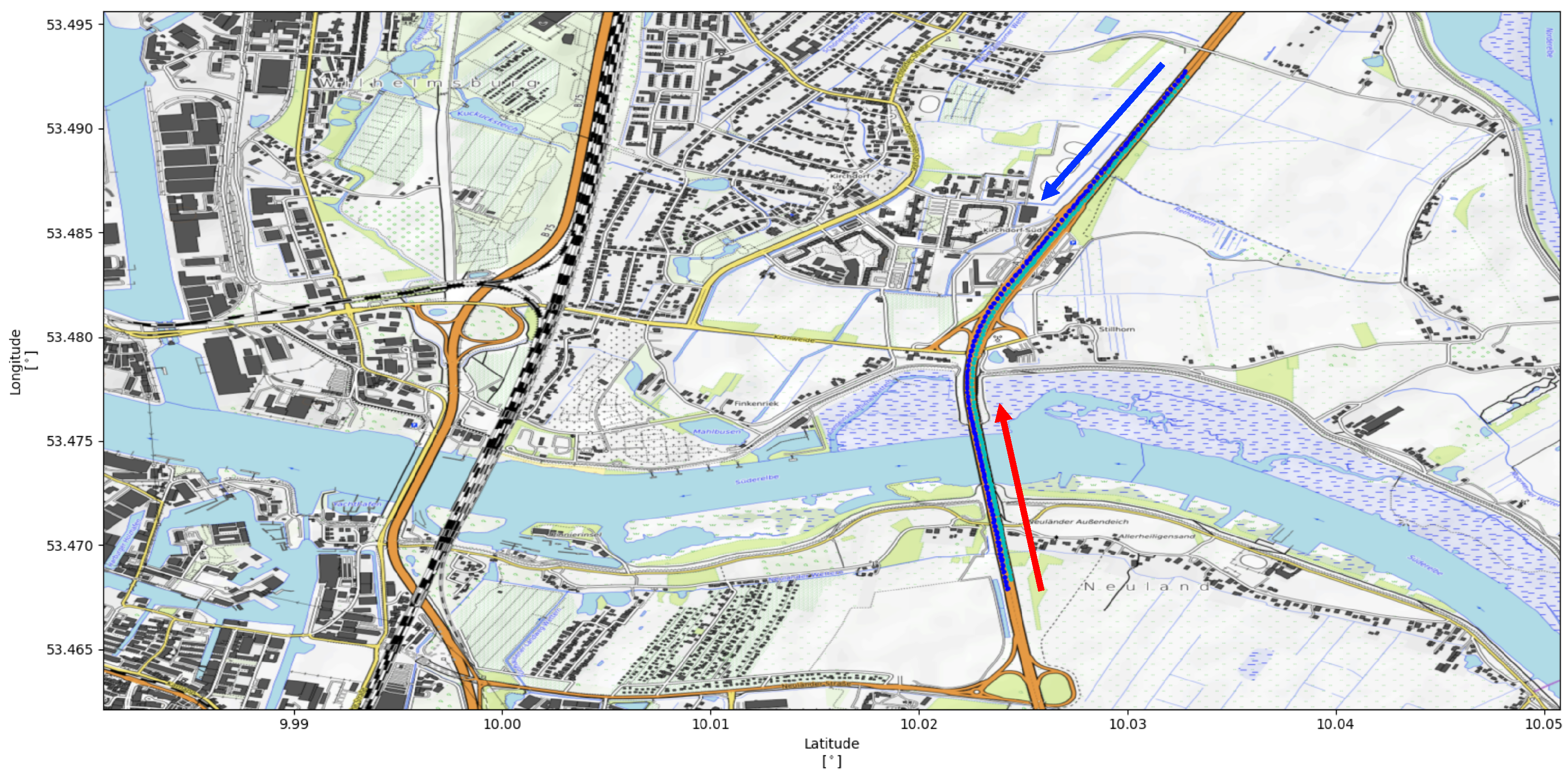
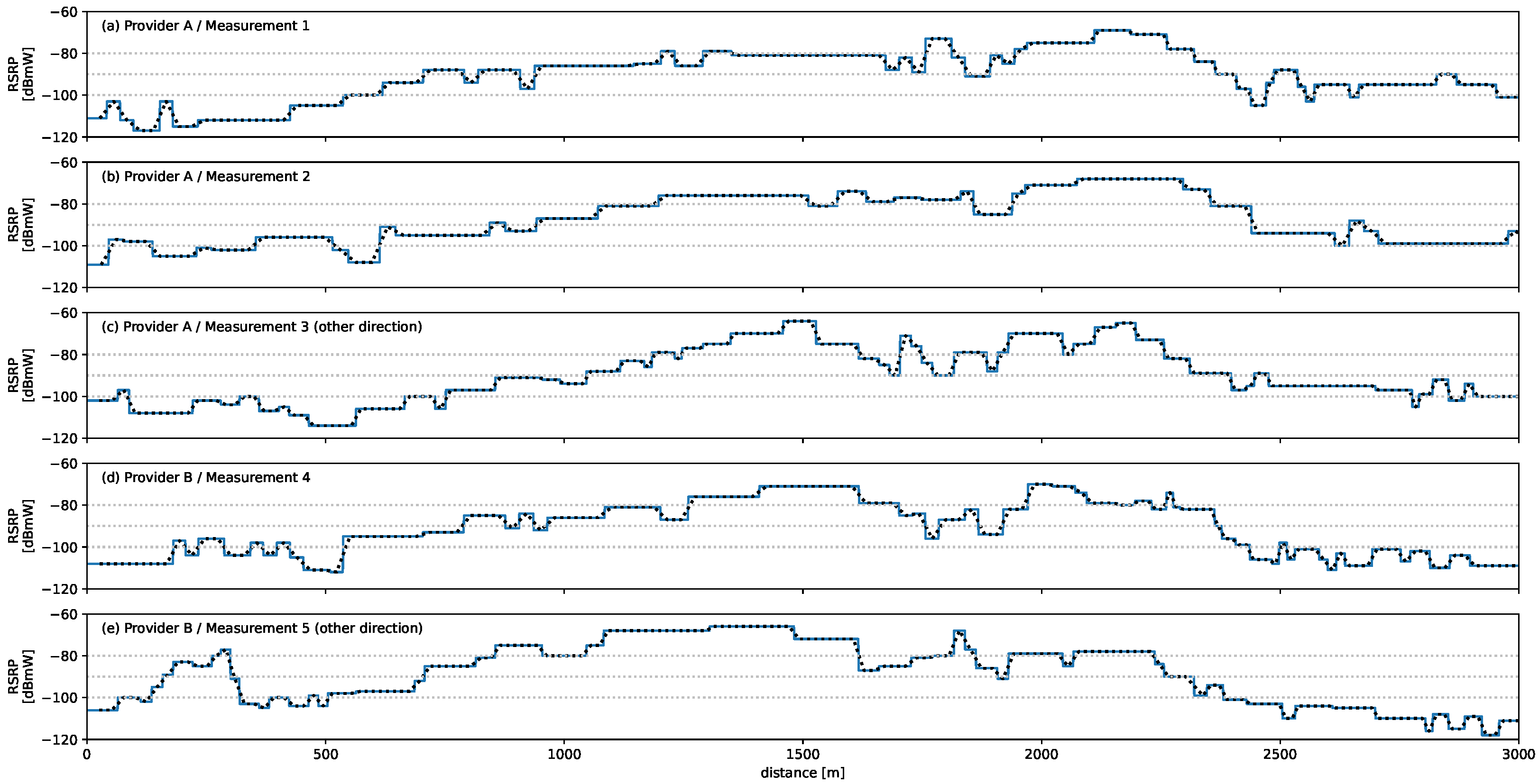
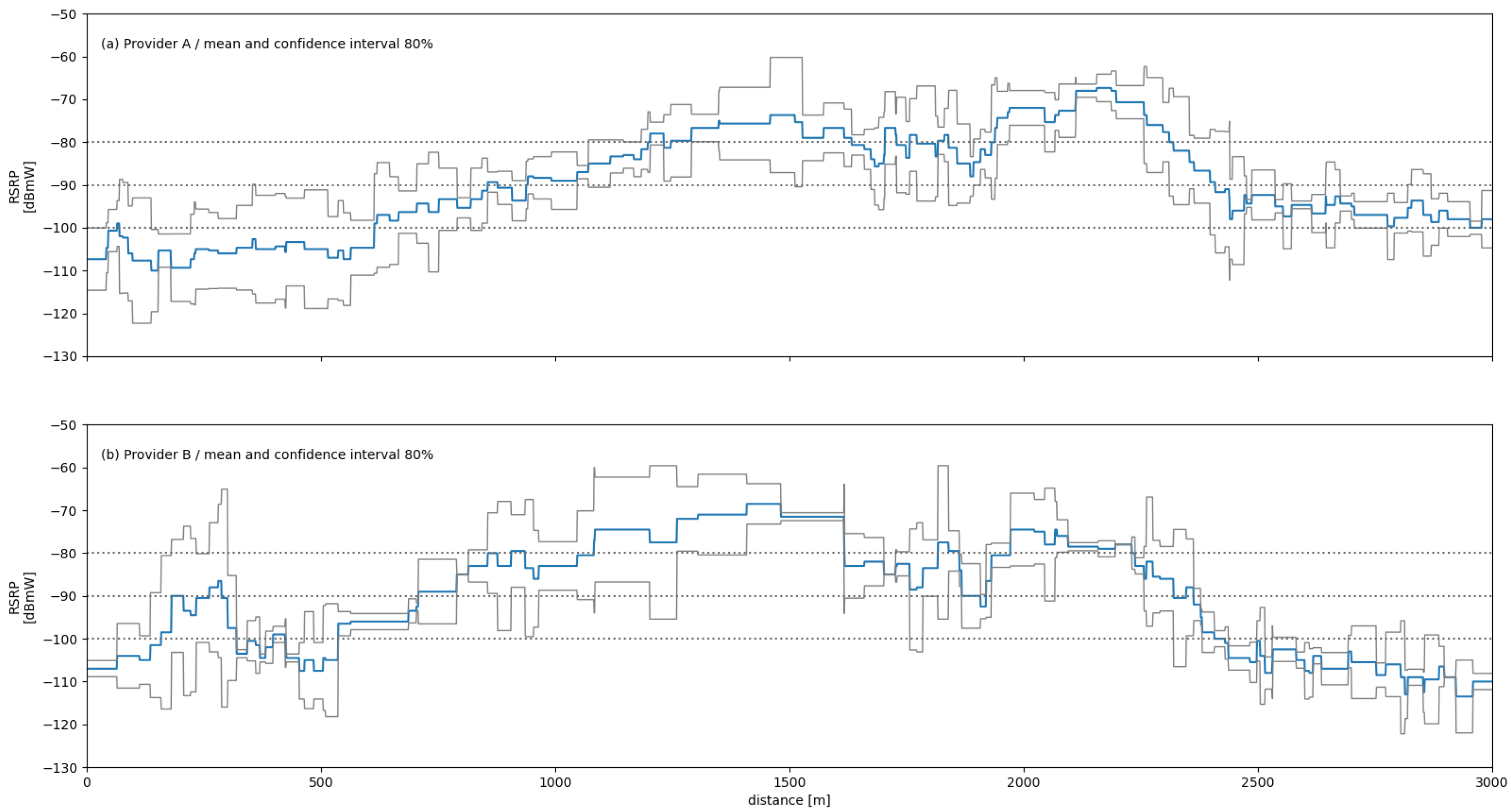
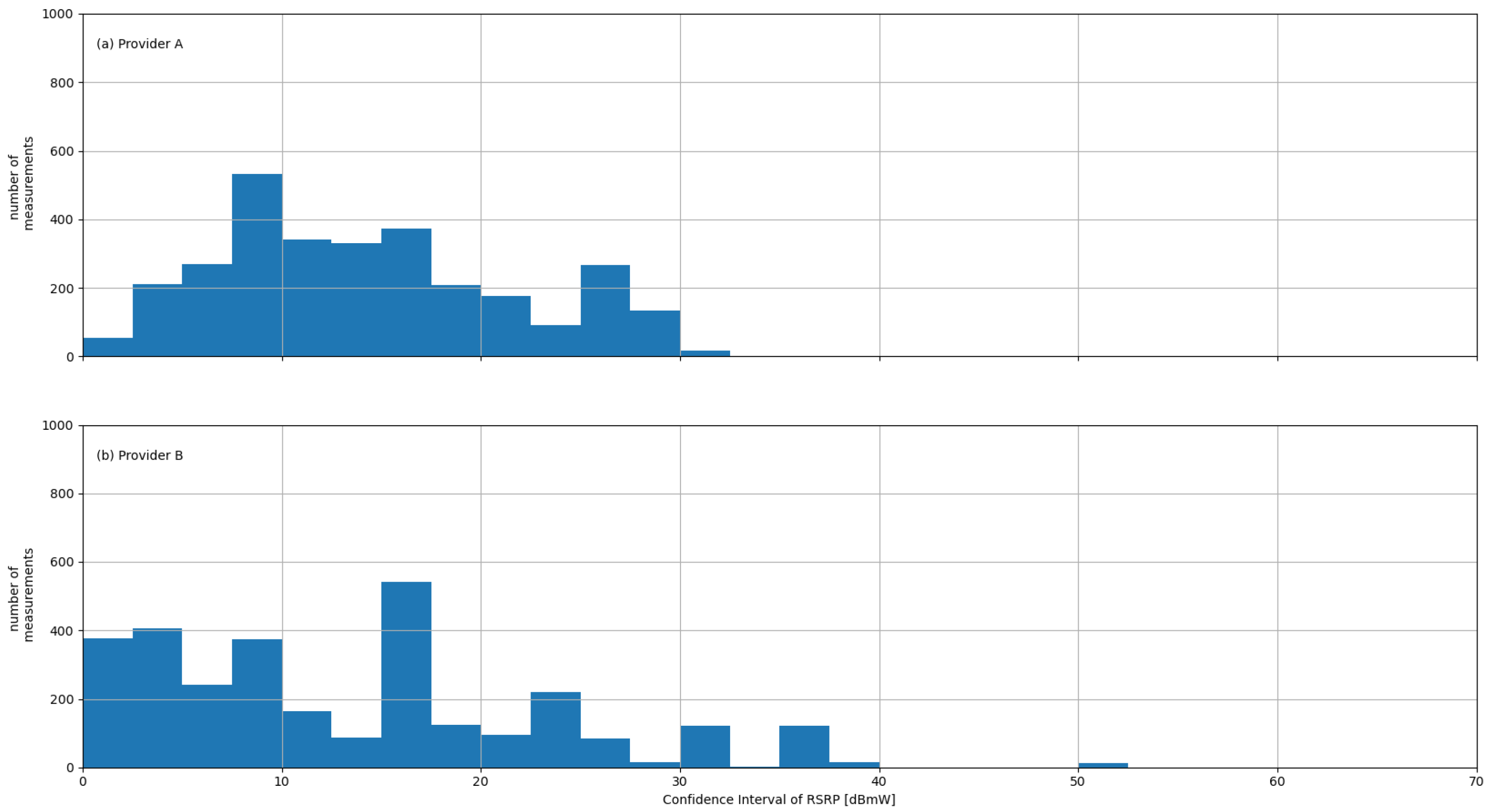
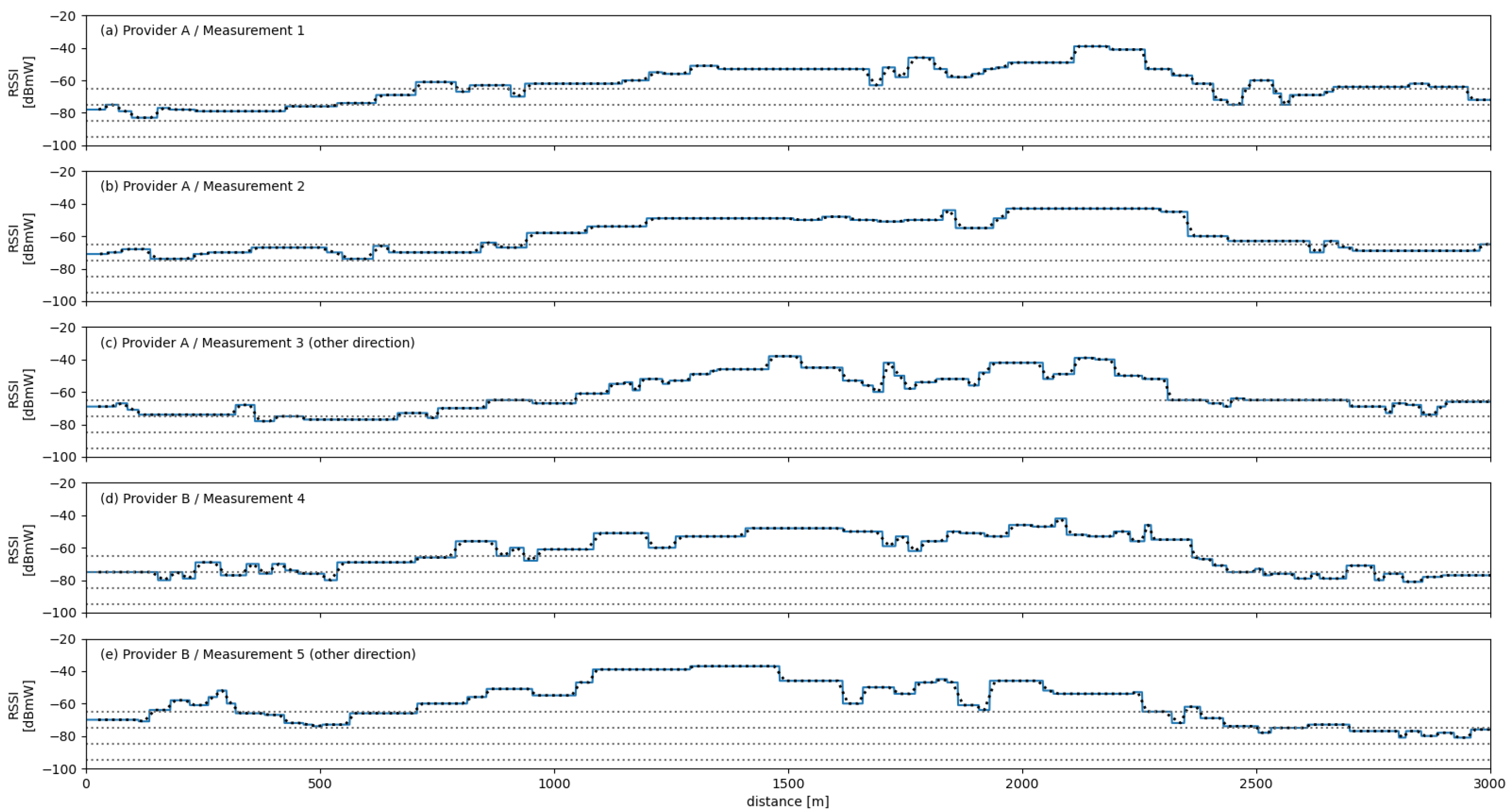

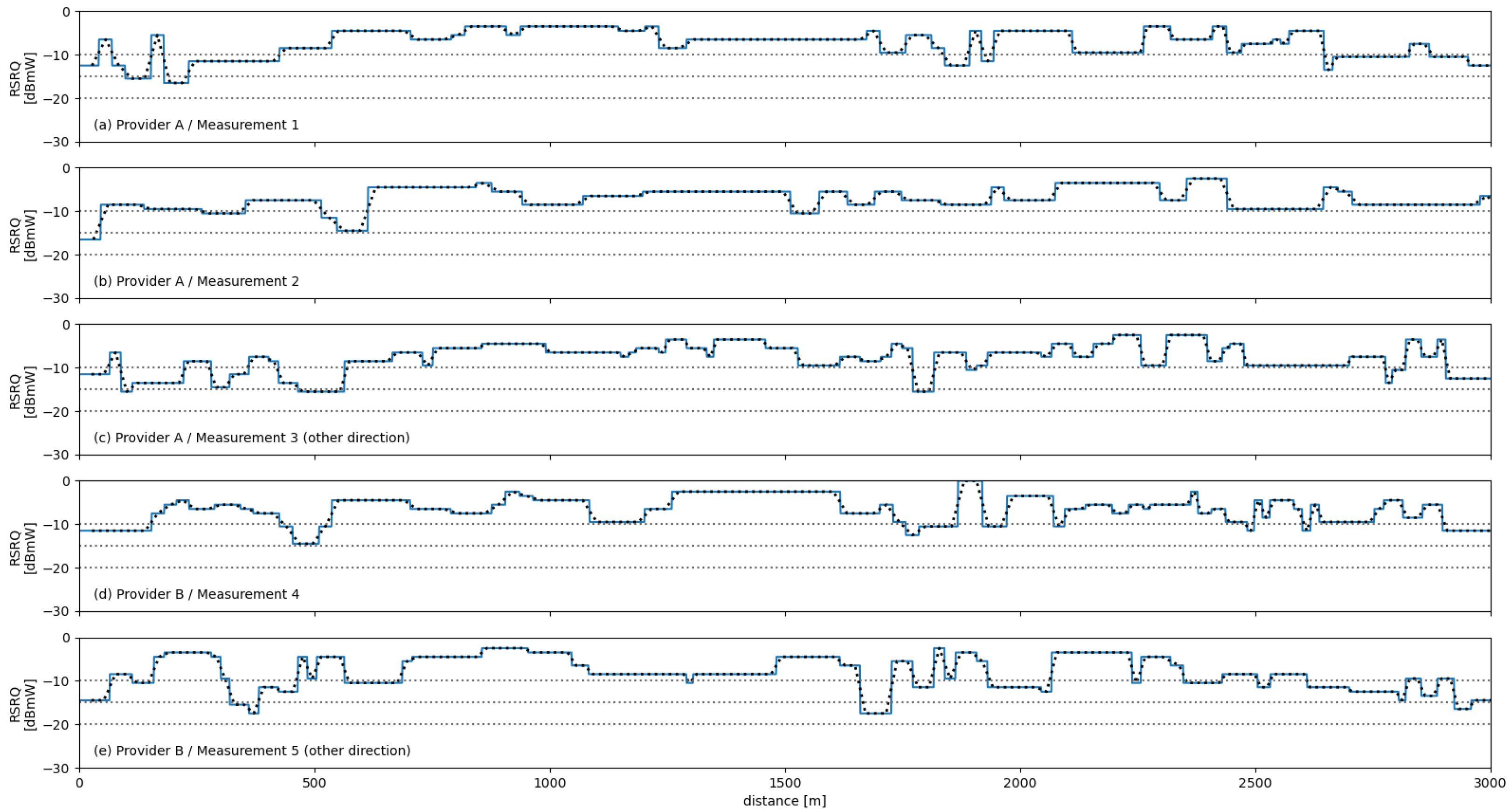
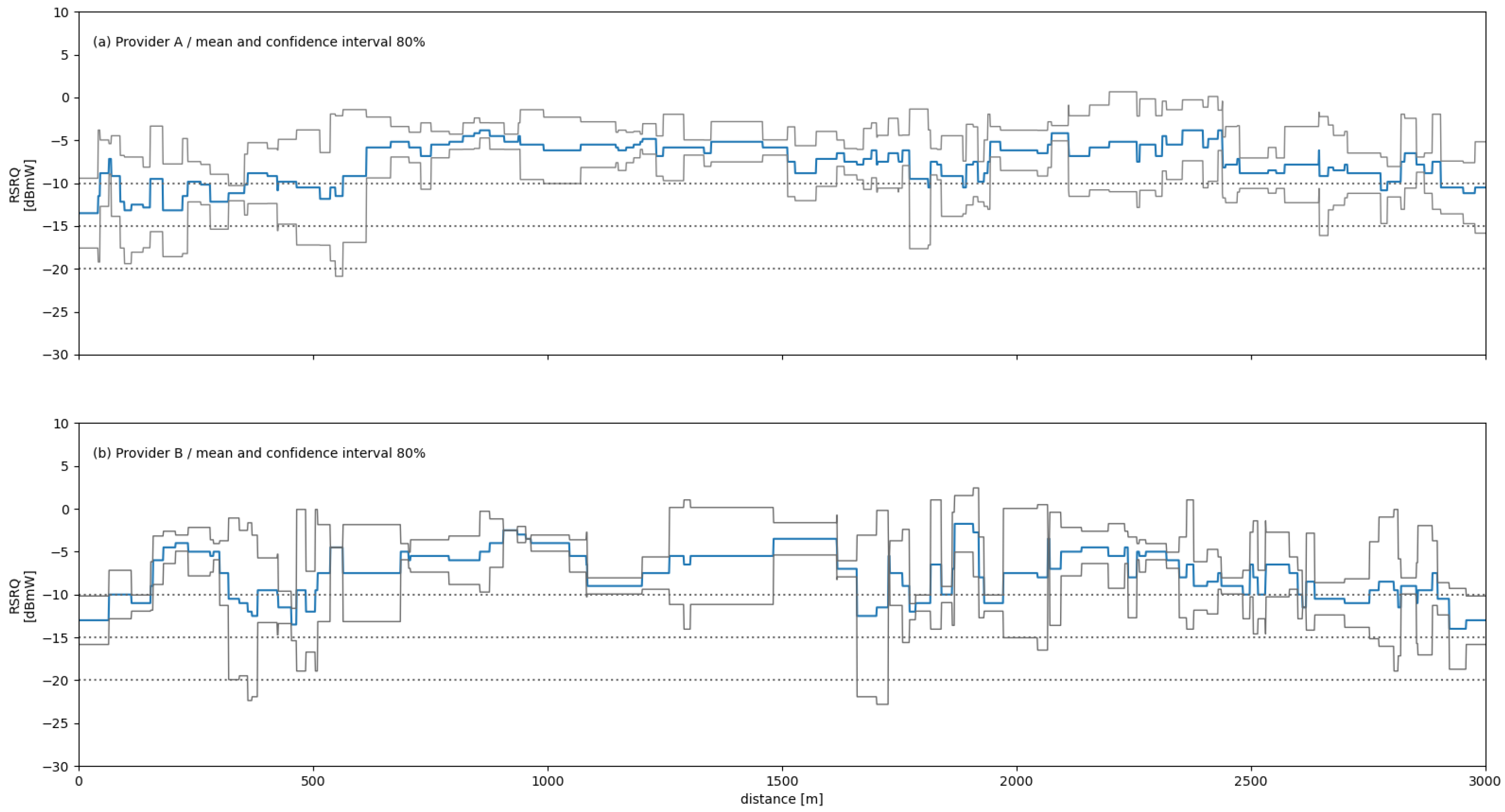
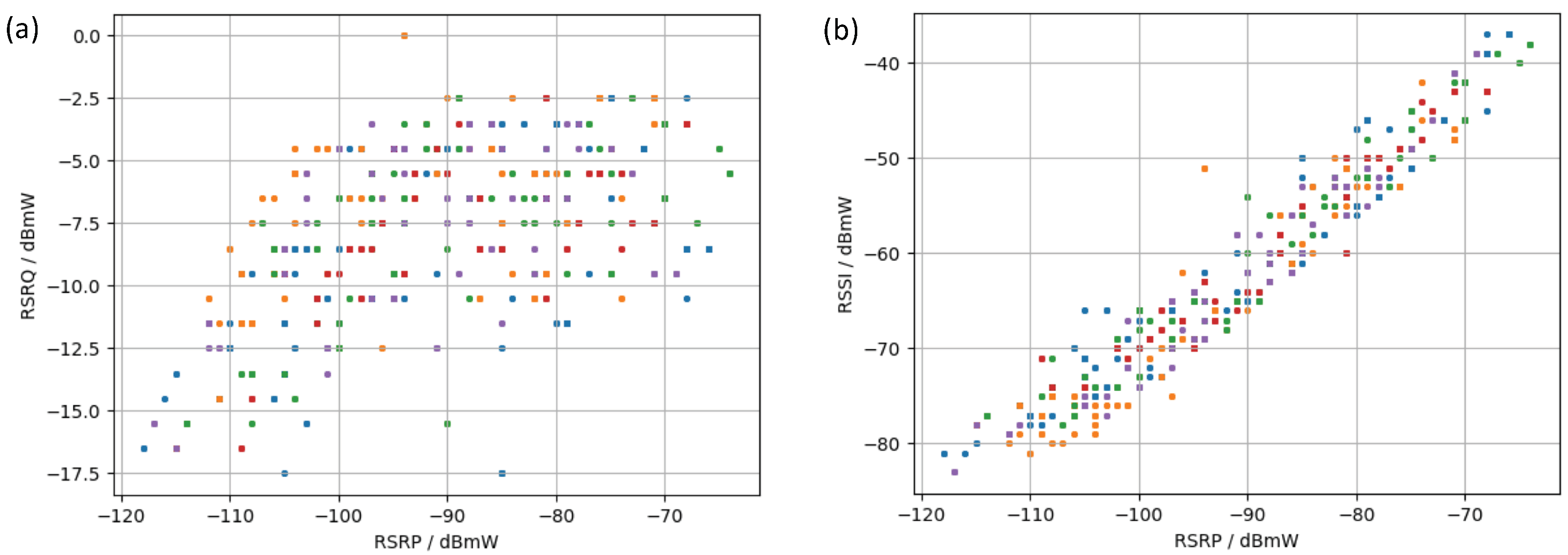
| Service Specific, Complex Characteristics | Simple, Directly Measurable Parameters |
|---|---|
| Quality of Experience (QoE) | Reference Signal Received Power (RSRP) |
| Quality of Service (QoS) | Reference Signal Received Quality (RSRQ) |
| Received Signal Strength Indicator (RSSI) | |
| Delay, Latency | |
| Packet Loss |
| Reference | Networks | Measurement | Parameters | Parameters |
|---|---|---|---|---|
| Assessed | Method | Controlled | Under Investigation | |
| [23] | 4G | crowd sourced | - | RSRP, RSRQ, latency, data rate |
| [22] | 4G | phone, scanner | position | RSRP |
| [25] | 4G | phone | time | RSRP |
| [33] | 4G | phone | time | RSRP, RSRQ, RSSI, others |
| [26] | 2G–4G, WiFi | crowd sourced | time, position | data rate, latency |
| [27] | 4G | modem | position | RSRP, RSRQ, RSSI, others |
| [28] | 3G,4G | phone | - | CSS, web browsing, streaming |
| [29] | 3G, 4G | phone | - | CSS, web browsing, streaming |
| [30] | 3G, 4G | phone | position | RSRP, RSRQ, RSSI, others |
| [31] | 2G–4G | phone | position | RSRP, others |
| this study | 4G | dedicated setup | time, position direction | RSRP, RSRQ, RSSI |
| Parameter | Range/Resolution /Format | Unit |
|---|---|---|
| Latitude | 0.000001 | ° dec. |
| Longitude | 0.000001 | ° dec. |
| Time of day | YYYY-MM-DD HH:MM:SS.000 | - |
| Data rate | 1 | Hz |
| RSRP | −120 … 0 | dBmW |
| RSSI | −120 … 0 | dBmW |
| RSRQ | −10 … 0 | dB |
| Number of operators LTE (4G) | 3 | - |
| Number of operators GSM (2G) | 3 | - |
| Assessment | RSRP | RSRQ | RSSI |
|---|---|---|---|
| excellent | >= −10 dBmW | >= −10 dB | > −15 dBmW |
| good | −10 dBmW …−10 dBmW | −10 dB …−15 dB | −15 dBmW …−15 dBmW |
| fair | −10 dBmW …−100 dBmW | −15 dB …−10 dB | −15 dBmW …−15 dBmW |
| poor | −15 dBmW …−15 dBmW | ||
| risk of disconnect or no signal | <= −100 dBmW | <= −10 dB | < −15 dBmW |
| (a) | (b) | (c) | (d) | (e) | ||
|---|---|---|---|---|---|---|
| A | A | A | B | B | ||
| (a) | A | 1 | 0.84 | 0.82 | 0.76 | 0.59 |
| (b) | A | 0.84 | 1 | 0.86 | 0.75 | 0.60 |
| (c) | A | 0.82 | 0.86 | 1 | 0.78 | 0.67 |
| (d) | B | 0.76 | 0.75 | 0.78 | 1 | 0.85 |
| (e) | B | 0.59 | 0.60 | 0.67 | 0.85 | 1 |
| Measurement | Provider | Excellent | Good | Fair to Poor | Risk of Disconnect or No Signal | Range under Analysis |
|---|---|---|---|---|---|---|
| (a) | A | 520 m | 1164 m | 663 m | 654 m | 3001 m |
| (b) | A | 1014 m | 584 m | 1078 m | 361 m | 3001 m |
| (c) | A | 881 m | 500 m | 949 m | 671 m | 3001 m |
| (d) | B | 715 m | 735 m | 602 m | 949 m | 3001 m |
| (e) | B | 1176 m | 555 m | 439 m | 831 m | 3001 m |
| (a) | (b) | (c) | (d) | (e) | ||
|---|---|---|---|---|---|---|
| A | A | A | B | B | ||
| (a) | A | 1 | 0.86 | 0.84 | 0.74 | 0.55 |
| (b) | A | 0.86 | 1 | 0.88 | 0.80 | 0.64 |
| (c) | A | 0.84 | 0.88 | 1 | 0.78 | 0.67 |
| (d) | B | 0.74 | 0.80 | 0.78 | 1 | 0.82 |
| (e) | B | 0.55 | 0.64 | 0.67 | 0.82 | 1 |
| Measurement | Provider | Excellent | Good | Fair to Poor | Risk of Disconnect or No Signal | Range Under Analysis |
|---|---|---|---|---|---|---|
| (a) | A | 1983 m | 431 m | 587 m | - | 3001 m |
| (b) | A | 1737 m | 1264 m | - | - | 3001 m |
| (c) | A | 1294 m | 1380 m | 327 m | - | 3001 m |
| (d) | B | 1515 m | 599 m | 887 m | - | 3001 m |
| (e) | B | 1767 m | 828 m | 406 m | - | 3001 m |
| (a) | (b) | (c) | (d) | (e) | ||
|---|---|---|---|---|---|---|
| A | A | A | B | B | ||
| (a) | A | 1 | 0.22 | 0.33 | 0.39 | 0.34 |
| (b) | A | 0.22 | 1 | 0.48 | 0.11 | 0.16 |
| (c) | A | 0.33 | 0.48 | 1 | 0.33 | 0.21 |
| (d) | B | 0.39 | 0.11 | 0.33 | 1 | 0.41 |
| (e) | B | 0.34 | 0.16 | 0.21 | 0.41 | 1 |
| Measurement | Provider | Excellent | Good | Fair to Poor | Risk of Disconnect or No Signal | Range under Analysis |
|---|---|---|---|---|---|---|
| (a) | A | 2238 m | 655 m | 108 m | - | 3001 m |
| (b) | A | 2702 m | 253 m | 46 m | - | 3001 m |
| (c) | A | 2377 m | 456 m | 168 m | - | 3001 m |
| (d) | B | 2413 m | 588 m | - | - | 3001 m |
| (e) | B | 1909 m | 927 m | 165 m | - | 3001 m |
Publisher’s Note: MDPI stays neutral with regard to jurisdictional claims in published maps and institutional affiliations. |
© 2022 by the authors. Licensee MDPI, Basel, Switzerland. This article is an open access article distributed under the terms and conditions of the Creative Commons Attribution (CC BY) license (https://creativecommons.org/licenses/by/4.0/).
Share and Cite
Rettig, R.; Schöne, C.; Fröhlich, F.; Niemöller, C. Method for Systematic Assessment of Mobile Network Coverage for Logistic Applications on the German Highway. Network 2022, 2, 311-328. https://doi.org/10.3390/network2020020
Rettig R, Schöne C, Fröhlich F, Niemöller C. Method for Systematic Assessment of Mobile Network Coverage for Logistic Applications on the German Highway. Network. 2022; 2(2):311-328. https://doi.org/10.3390/network2020020
Chicago/Turabian StyleRettig, Rasmus, Christoph Schöne, Frederik Fröhlich, and Christopher Niemöller. 2022. "Method for Systematic Assessment of Mobile Network Coverage for Logistic Applications on the German Highway" Network 2, no. 2: 311-328. https://doi.org/10.3390/network2020020
APA StyleRettig, R., Schöne, C., Fröhlich, F., & Niemöller, C. (2022). Method for Systematic Assessment of Mobile Network Coverage for Logistic Applications on the German Highway. Network, 2(2), 311-328. https://doi.org/10.3390/network2020020






